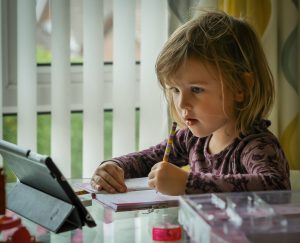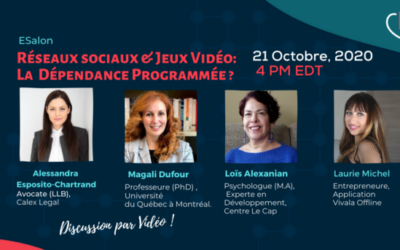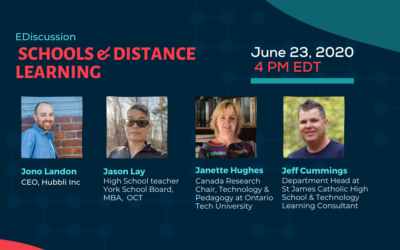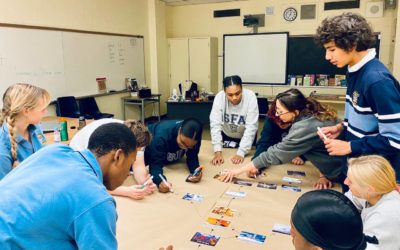As classes moved online during the Covid pandemic, many teachers moved to giving lectures online, through video conferencing, making “Zoom” a household name in 2021. However, teaching online is very different from delivering the same class given in person, even through many elements of best practices in pedagogy are common. It is also very different from “autonomous, or self-paced learning”, as online teaching is often wrongly construed.
Below are best practices in online teaching or remote learning from Professors Bill Muirhead and Lorayne Robertson, of Ontario Tech University’s School of Education (Canada), related to a course on online privacy.
Source: eBook on Digital Privacy: Leadership and Policy ( Master’s in Education course)
Digital Privacy Course Design Best Practices:
Here are the mid-level structural elements that have been designed into the course to include best practices for online teaching:
- Alignment of the learning objectives with the learning activities, readings and assignments,
- Flipped classroom,
- Distributed learning
- Collaboration and Community
- Critical pedagogy
In the next section, we explain each of these elements of deliberate pedagogical design.
A: Alignment of Learning Outcomes with the Activities and Readings
The learning outcomes for the Digital Privacy: Leadership and Policy course are listed in the course outline. Keen observers will notice that each of the learning outcomes has been addressed at least ten times throughout the course’s four modules. In simple terms, here are some of the outcomes.
Upon completion of the course, students should be able to:
- Articulate what they have learned and show connections between theory, evidence and practice.
- Use a wide range of technology for communication.
- Critically assess the affordances and constraints of technology and make evidence-based decisions about the best ways to use technology.
- Critically evaluate information in the course and how digital technology impacts and is impacted by society and communities.
- Prepare materials to educate different audiences.
- Engage in ongoing reflection and debate and show the ability to make complex decisions.
- Demonstrate integrity and ethical behaviour.
Our goal in designing the course was to have students return continuously to these learning outcomes multiple times. Accordingly, the outcomes are reflected in all of the course modules, readings and assignments.
B: Flipped Classroom
Another element of best practices in online teaching is to have elements that are studied by students before, during and after class. According to Eddy and Hogan (2014), moving much of the information transmission to before class has been found to free up 34.5% more time during class to reinforce major concepts, higher-order thinking and study skills. This strategy allows students to spend as much time as they need to fully prepare for class. Engaging students in preparing for the course in advance of the class promotes academic achievement and is significantly helpful for learners who are first-generation post-secondary students (Eddy & Hogan, 2014). Below is a quick overview of how this works.
Before class: Students review the slides for the class and study the assigned readings in order to prepare for class. In this way, when they come to the online, synchronous class, they have accessed the knowledge for that topic and are better prepared for discussions and other in-class activities. The readings for this course have been carefully selected to align with the course learning outcomes. Knowing that some students are keenly interested in this topic, we have provided additional readings at multiple points. Pre-class preparation may also include videos and activities.
During class: The Instructor assumes that the students have reviewed the slides and they are familiar with the readings. Accordingly, the instructor spends less time providing information so that more of the class time is dedicated to:
- Understanding students’ experiences with this digital privacy topic,
- Applying the knowledge learned to real-life scenarios,
- Engaging in academic discourse and problem-solving on the topic.
After class: Students are assigned coursework to complete after class. This includes preparation for the next week and assignments.
C: Distributed Learning

Distributed learning (also called the pacing effect) is another element of best practices in online teaching that paces students’ learning. It is the opposite of cramming at the last minute and hoping to pass the course. It is also not “self-paced learning”. Better learning occurs when the learning opportunities are spaced apart rather than happening close together.
When learning is spaced apart, it is more likely to have the students’ attention and they are more likely to connect it to other contexts (Carpenter, 2020). Students spread out the time they spend on a concept with pre-reading activities, in-class assignments, and post-class reviews. This has a direct impact on how well they perform in the course (Eddy & Hogan, 2014). Distributing the learning also allows the students to cycle back to the key concepts in a course frequently.
Synchronous discussions between the instructor and student that mimic the established office hours of old create an environment where instructor and students are engaged in a context of learning together and exploring in unison.
This course has some cumulative assignments related to the case study. Students craft a plan for a case study and receive feedback. Throughout the course, they identify policies related to their case study and seek solutions. They present their case study to the other students and then use this case study as the basis for their final, collaborative paper. Giving early feedback helps to build a student’s sense of safety that they are “on the right track.” The second assignment builds on the first, and the final assignment is a culmination of their learning in the course.
Rich asynchronous feedback with synchronous discussions between the instructor and student that mimic the established office hours of old combine to create an environment where instructor and students are engaged in a context of learning together and exploring in unison.
D: Collaboration and Community
More and more, instructors are moving away from teacher-centred pedagogies, where the instructor is the source of information. In this course, we rely on the students to research topics thoroughly before class and come to class with a good understanding of the topic and key questions. In this way, students can add their prior experience to the discussions. It is important to design learning activities in the course where students interact and share knowledge.
Social presence is a key element to deeper cognitive engagement, critical thinking, and student success.
Students in online courses are encouraged to share their cameras and their voices so that others can get to know them. Garrison (2009) describes social presence as “the ability of participants to identify with the community (e.g., course of study), communicate purposefully in a trusting environment, and develop interpersonal relationships by way of projecting their individual personalities” (p. 352).
Garrison (2011) explains further that, “where social presence is established, students will be able to identify with the group, feel comfortable engaging in open discourse, and begin to give each other feedback” (p. 33). We would argue that social presence is a key element to deeper cognitive engagement, critical thinking and student success.
Another deliberate element of the design of this course is collaboration. Johnson et al. (1994) first defined collaborative learning through the concept of positive interdependence. This is where group members assume responsibility for ensuring that the group is successful and students, in turn, can depend on other group members to do their part. This course was designed to encourage students to develop both social presence and collaboration skills.
Earlier models of online learning had fewer opportunities for collaboration in real-time. Today’s technologies allow students to participate in courses and share dialogue, video and images. They can use multiple communication channels simultaneously, such as using the Chat as a backchannel to ask questions or affirm comments in a way that does not interrupt the flow of the discussion in class.
Google’s G-Suite allows students to collaborate in real-time for document creation or asynchronously. Some students use quasi-synchronous forms of chat, such as WhatsApp, that allow real-time responses or responses with a short delay. According to Dalgarno (2014), these affordances allow students to engage more deeply with the topic.
E: Critical Pedagogy

In this text, the authors have taken a critical stance toward interrogating the concepts of digital privacy and surveillance in education. We have recognized that, as Apple (1999) has stated, much of our understanding has come from the dominant cultural groups in society. Kincheloe (2008), a critical pedagogy scholar, argues that we have assumed that what we have learned in school and the academy is inherently what is “best” for students.
Critical scholars know, however, that our schooling history had gaps and omissions. There are other ways of knowing and other experiences that were left out of traditional education. This preferential treatment of colonial, patriarchal, monocultural knowledge was presented as “neutral” but it has negatively impacted the education of members of marginalized groups. Processes considered “best practices” may not be the most inclusive educational practices.
In order for change to happen, teachers must become researchers and question past assumptions. Educator-researchers also need to interrogate past practices where teachers were considered the deliverers of information that may have represented a singular reality or an oversimplification of issues that require complex complicated considerations.
One key to questioning dominant perspectives is to see how power is linked to the political economy and to examine its effects on individuals who are at different social locations (Kincheloe, 2008). Accordingly, in this e-book, the authors examine digital privacy in education in its complexity and encourage educator-researchers to interrogate assumptions within what Garrison (2011) has described as a community of inquiry.
Freire’s (2007) pedagogical approach encourages students not to accept that “what is” is the way that it will always be (p. 84). His pedagogy encourages the cultivation of a critical consciousness in his students, where they seek to understand the social, political and economic contradictions. Freire encouraged individual empowerment for social change (Freire, 2007). We take a similar approach to student empowerment in the Digital Privacy: Leadership and Policy course and in this accompanying e-book.
In Chapter 2, for example, Robertson and Corrigan question the dominant narratives surrounding youth surveillance in education and encourage instead an approach where students, parents and schools share responsibilities.
In Chapter 4, Robertson and Muirhead present a critical policy analysis framework that encourages educator-researchers to examine whose perspectives have been considered and whose are missing in policy design and implementation.
Policy paradoxes in Chapter 6 are inherently complex and contested. In the final chapter, Case Studies, we encourage teacher-researchers to explore digital privacy cases in their complexity and feel empowered to call for change and renewal.
For more discussion on best practices in teaching online, see our past discussions with four Canadian experts in Tech and Pedagogy:
Kids and Teens Mental Health at stake with Canadian Schools adopting Distance Learning Well
The New Normal in Education Challenges Universities and Colleges on Privacy and Quality of Learning







